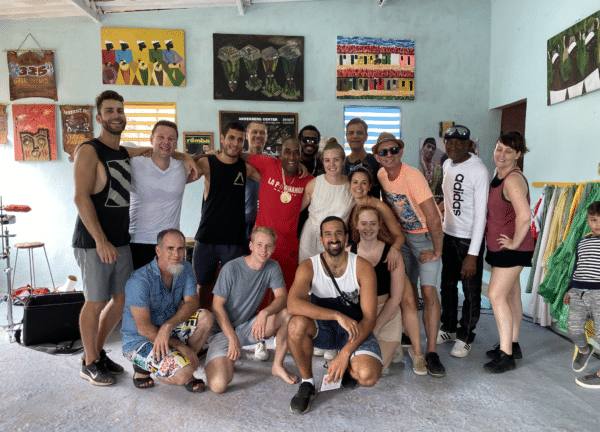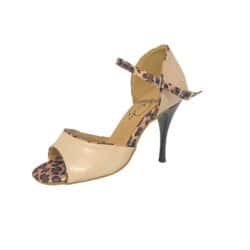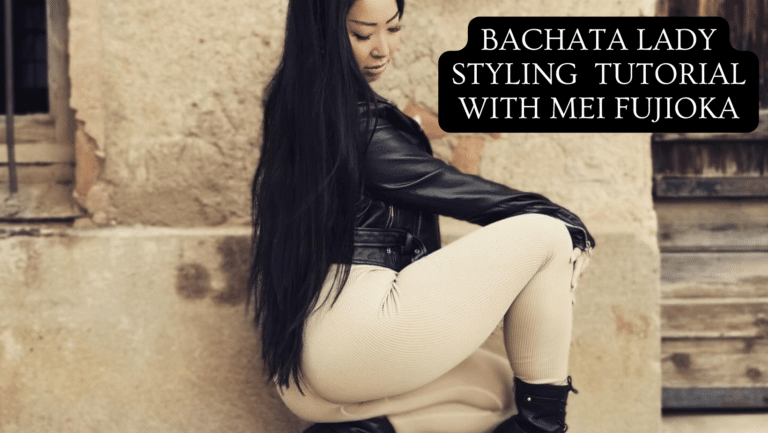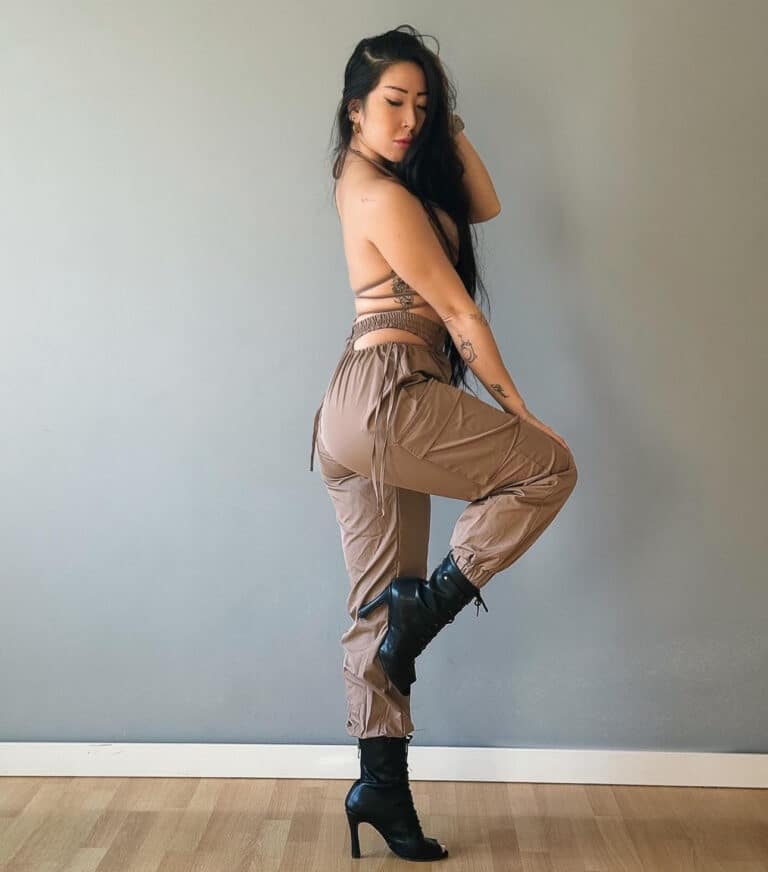What Is Rumba Cubana?
Last Updated on June 1, 2023 by Clement
What is Rumba Cubana?
What is Rumba Cubana? In this article we will talk about what is Cuban Rumba: History, origins, characteristics, instruments and dance steps! We will finally see how Rumba Cubana influenced other dances! We had the amazing chance to meet some. of the amazing rumba cubana artists such as Los Munequitos de matenza and share an amazing cultural experience with them! We hope you will enjoy this article !
What is Rumba Cubana?

What Is Rumba Cubana? Introduction to Cuban Rumba
Rumba Cubana, also known simply as Rumba, is a genre of Cuban music and Cuban dance that has been captivating audiences around the world for over a century. Rumba is a fusion of African rhythms, Spanish guitar music, and other elements that have come together to create a unique and vibrant musical style. This genre of music and dance is deeply rooted in Afro-Cuban culture and has played an important role in preserving the heritage of Cuba’s African descendants.
1- Etymology of Rumba
The word “rumba” originated in the late 19th century in Cuba and is believed to have originated from the African word “rumbo”, meaning “party” or “conga”. The dance style was developed in Cuba and later spread to other parts of Latin America and the Caribbean. In the early 20th century, the term “rumba” was also used to describe a genre of music that was popular in Cuba and later became known as “Cuban Rumba”.
2- Origins of Cuban Rumba
Rumba originated in Cuba in the late 19th century and has since become one of the most popular and recognizable forms of Latin music. It is said to have developed from the musical traditions of enslaved Africans brought to Cuba as part of the transatlantic slave trade. These enslaved Africans brought with them their musical traditions, which eventually merged with Spanish guitar music to create the roots of Rumba Cubana. Over time, Rumba evolved to reflect the social and political climate of Cuba, as well as the influence of other musical styles and cultures.
Historically, the growth and popularity of rumba in Cuba was centered in marginal neighborhoods of cities such as Havana and Matanzas, near ports and shantytowns, with a strong presence in rural areas where African slave communities lived.
3- Different types of Rumba: Rumba Guaguanco, Rumba Columbia & Rumba Yambu
There are several different styles of Rumba, each with its own distinct rhythms, instruments, and dance moves. The three main styles of Rumba are Rumba Guaguancó, Rumba Columbia, and Rumba Yambú.
1- Rumba Guaguanco
Rumba Guaguancó is the most popular and well-known style of Rumba and is characterized by its fast pace, intricate rhythms, and lively dance moves.
2- Rumba Columbia
Rumba Columbia is a slower and more sensual style of Rumba, known for its romantic lyrics and romantic dance style.
3- Rumba Yambu
Rumba Yambú is the slowest and most traditional style of Rumba, characterized by its slower tempo and more relaxed dance moves.
Dance Shoes For Salsa | Best Guide
4- Rumba dance and music has been spreading through the world
Rumba Cubana has spread throughout the world and has been embraced by many different cultures and communities. In the United States, Rumba has been particularly popular in cities with large Latin communities, such as Miami and New York. Rumba has also been embraced by the global music community, with many musicians and DJs incorporating elements of Rumba into their own musical styles.
What is Rumba Cubana?

What is Rumba Cubana?
History of Rumba Cubana
Rumba Cubana has its roots in African music, and the influence of Spanish guitar music can also be seen in its sound. The genre was born in Cuba in the late 19th century, and its early evolution was shaped by the experiences of Afro-Cubans and the social and political climate of the time.
1- Rumba: Musical Traditions of the Yoruba People of West Africa
Rumba’s African roots can be traced back to the musical traditions of the Yoruba people of West Africa, who were brought to Cuba as part of the transatlantic slave trade. These enslaved Africans brought with them their musical traditions, which eventually merged with Spanish guitar music to create the roots of Rumba Cubana. The result was a unique and vibrant musical style that reflected the experiences and culture of Afro-Cubans.

2- Cuban Rumba became a form of expression and communication
In the late 19th and early 20th centuries, Rumba Cubana became a form of expression for Afro-Cubans, and it was greatly influenced by the social and political climate of Cuba. The genre was often used as a way for Afro-Cubans to express their frustrations with their social and economic conditions, and it was also used to celebrate their cultural heritage and traditions.
3- Evolution of Rumba Cubana
Throughout the 20th century, Rumba Cubana continued to evolve and change. It was influenced by a variety of musical styles and cultures, including jazz, swing, Latin Jazz and other forms of Latin music. Some of the most notable artists who contributed to the development of Rumba Cubana over time include Abelardo Barroso, Ignacio Piñeiro, and Bienvenido Granda.
Cuban Salsa Moves Names & Video
4- Cuban rumba became a symbol of Cuban National Identity
In the 1950s and 1960s, Rumba experienced a resurgence in popularity, and it became a symbol of Cuban national identity. The genre was embraced by musicians and audiences alike, and it was seen as a way to express pride in Cuban culture and heritage. This renewed interest in Rumba also led to a greater appreciation of the genre’s unique sound and musical styles.
5- Importance of Rumba during the Cuban Revolution
One of the most significant events in the history of Rumba Cubana was the Cuban Revolution of 1959. The revolution brought about significant social and political changes in Cuba, and it had a profound impact on the country’s musical culture as well. During this time, Rumba continued to be used as a means of expression, and it was often used to comment on the political and social changes taking place in the country.
SHOP NOW
In recent decades, Rumba Cubana has continued to evolve and grow in popularity. The genre has been embraced by musicians and audiences around the world, and it has been incorporated into a variety of different musical styles and cultures. Today, Rumba Cubana remains one of the most recognizable and beloved forms of Latin music, and it continues to play an important role in preserving the cultural heritage of Afro-Cubans.
What Is Rumba Cubana?
In addition to its rich history and cultural significance, Rumba Cubana is also renowned for its intricate rhythms, lively dance moves, and romantic lyrics. The genre continues to captivate audiences around the world with its unique sound and passionate spirit, and it remains an important part of Cuba’s cultural heritage and national identity.
Salsa Dance Shoes for Narrow Feet
The Characteristics of Rumba Cubana Dance & Music
One of the most distinctive elements of Rumba Cubana is its rhythm. The genre is characterized by its fast-paced, syncopated beat, which is created by a combination of drums, percussion instruments, and the Spanish guitar. The rhythms in Rumba Cubana are complex and intricate, and they are designed to create a lively and energetic sound that encourages dancing.
What is Rumba Cubana?

1- Lead Singer
Another important element of Rumba Cubana is the role of the lead singer, who is responsible for improvising the lyrics and melody of the songs. Improvisation is a key component of Rumba Cubana, and it allows the singer to express their emotions and ideas in a spontaneous and creative way. The lead singer is also responsible for setting the pace and mood of the music, and they are often the center of attention during performances.
2- Cuban Rumba Dance
In addition to its musical elements, Rumba Cubana is also known for its lively and energetic dance moves. The dance is performed by a couple, and it is characterized by its fast and fluid movements, as well as its close physical proximity between partners. The dance is an integral part of Rumba Cubana, and it is designed to reflect the rhythms and emotions of the music.
SHOP NOW
3- Rumba Guaguanco & Connection
The connection between the music and the dance is one of the defining characteristics of Rumba Cubana. The dance is designed to reflect the rhythms and emotions of the music, and the music is created to inspire and accompany the dance. This close relationship between the music and the dance is what makes Rumba Cubana such a dynamic and engaging form of expression.

4- Instruments of Rumba Cubana
In terms of instruments, Rumba Cubana is known for its use of drums, percussion instruments, and the Spanish guitar. The drums and percussion instruments provide the foundation for the music, while the Spanish guitar adds melody and harmony. These instruments are used to create a rich and varied sound that is distinctive to Rumba Cubana.
5- Cuban Rumba Dance Improvisation
Finally, it’s worth mentioning the importance of improvisation in Rumba Cubana. Improvisation is a key component of the genre, and it allows musicians and dancers to express themselves in a spontaneous and creative way. This improvisational element gives Rumba Cubana its dynamic and unpredictable energy, and it is one of the reasons why the genre continues to captivate audiences around the world.
6- Cuban Rumba Dance moves Video

What is Rumba Cubana?
The Legacy Of Cuban Rumba in the world and in the different latin dance styles
Rumba Cubana, also known as Cuban Rumba, is a genre of music and dance that has had a profound impact on Cuban culture and the world at large. From its origins in African music, Rumba Cubana has evolved into a dynamic and vibrant form of expression that has been embraced by different cultures around the world. In this section, we will explore the legacy of Rumba Cubana and its place in the world of music and dance.
SHOP NOW
1- Preserving Afro-Cuban Heritage
One of the most significant impacts that Rumba Cubana has had on Cuban culture is its role in preserving Afro-Cuban heritage. The genre is steeped in the traditions and rhythms of African music, and it provides a powerful link to the cultural heritage of Afro-Cubans. By preserving this heritage, Rumba Cubana helps to keep the traditions and rhythms of African music alive in the modern world.
2- Influenced other musical styles such as Salsa, Jazz, Rock n Roll and Latin Jazz
In addition to its cultural significance, Rumba Cubana has also had a major impact on the world of music. The genre has influenced a wide range of other musical styles, including salsa, jazz, and even rock and roll. The syncopated rhythms and complex instrumentation of Rumba Cubana have inspired musicians and composers around the world, and the genre continues to be a major source of inspiration for new generations of musicians.
You can For example see in this Rueda de Casino one of the move called Enchufla Con Rumba, mixing steps from casino (Cuban Salsa) with traditional rumba cubana steps!

What is Rumba Cubana?
3- Captivate its audience through tradition rumba performances and improvisations
Another way in which Rumba Cubana has left its mark on the world is through its popularity and widespread appeal. The genre has been embraced by different cultures around the world, and it is performed and celebrated in many different countries. Whether it is in the form of traditional performances, or contemporary interpretations, Rumba Cubana continues to captivate audiences around the world with its lively rhythms and dynamic energy.
4- Connection to the dance
One of the reasons why Rumba Cubana has been so widely embraced is its connection to the dance. The genre is characterized by its fast-paced, syncopated rhythms, which are designed to inspire and accompany the dance. The close relationship between the music and the dance is what gives Rumba Cubana its unique energy and appeal, and it is one of the reasons why the genre continues to be popular today.
5- Rumba Cubana is deeply rooted in tradition
Despite its widespread popularity, Rumba Cubana continues to be a genre that is deeply rooted in tradition. The genre is steeped in the history and culture of Cuba, and it continues to be performed and celebrated in its traditional form. Whether it is in the form of traditional festivals and celebrations, or contemporary interpretations, Rumba Cubana remains a genre that is deeply connected to its roots.
Conclusion
In conclusion, the legacy of Rumba Cubana is one of cultural preservation, musical inspiration, and widespread appeal. From its roots in African music, Rumba Cubana has evolved into a dynamic and vibrant form of expression that has been embraced by different cultures around the world. Whether you are a fan of Latin music, or simply appreciate the beauty and energy of traditional dance forms, Rumba Cubana is a genre that is well worth exploring.
Rumba Cubana & Son Cubano
Read about Son Cubano Dance and Traditional Cuban Son Here

What is Rumba Cubana?
Rumba Cubana & Cuban Salsa (also called Casino)
Rumba Cubana Influenced hugely Cuban Salsa and Salsa Casino Dance Steps. Read More about Cuban Salsa. Moves Names

What is Rumba Cubana?
Rumba Cubana & Rueda De Casino

What is Rumba Cubana?
Related Articles and Dance:
What is Rumba Cubana?
Bachata Steps | Free Intermediate Bachata Dance Tutorial
What is Rumba Cubana?
Should You Size Up for Latin Dance Shoes? Do That to avoid Pain!
What is Rumba Cubana?
What is Rumba Cubana?
Rumba Dance Shoes & Latin Dance Shoes
What is Rumba Cubana?
10 Most Popular Rumba Cubana Music: Artists and songs
Before we list the 10 more popular Rumba Cubana artists, here are some of our favourites!
Los Muñequitos De Matanzas

Irakere – Atrevimiento

What is Rumba Cubana?
Top 10 Most Popular Rumba Cubana Bands, Cuban Rumba Artists and Rumba bands
1- La llave – Los Muñequitos de Matanzas
2- Los Papines – “Mi Quinto”
3- Grupo Danzon y Alexander Abreu – Rumba En Matanzas
4- Mayito Rivera con Yoruba Andabo – Si a una mamita
5- ADONIS Y OSAIN DEL MONTE – LA NEGRA
6- Ta’ Julian – Los Muñequitos de Matanzas
7- Raices Habaneras -Dame La Mano
8- Yoruba Andabo – El Callejon De Los Rumberos – Perdon
9- Óleo De Una Mujer Con Sombrero- Rumbatá
10- Conjunto Clave y Guaguancó – La Voz Del Congo
What is Rumba Cubana?
Connection between rumba cubana and Afro-Cuban religion and spirituality
Rumba cubana, a musical genre that originated in Cuba, is deeply rooted in Afro-Cuban religion and spirituality. The genre, known for its lively rhythm and upbeat style, has been an integral part of Cuban cultural and religious practices for centuries. In this article, we will explore the connection between rumba cubana and Afro-Cuban religion and the significance of the Orishas in this connection.
1- Afro-cuban Religion – Santeria & Orishas
Afro-Cuban religion, also known as Santería, is a fusion of West African, indigenous Cuban, and Catholic beliefs and practices. It was brought to Cuba by enslaved West Africans who arrived on the island between the 16th and 19th centuries. The religion is based on the worship of the Orishas, a pantheon of gods and goddesses that represent natural forces and aspects of life. The Orishas are seen as intermediaries between humans and the divine and are believed to have the power to bring positive change into people’s lives.
2- Music & dance celebrations to evoke the presence of the Orishas
In Afro-Cuban religion, music and dance play an important role in religious rituals and ceremonies. Rumba cubana, with its energetic rhythm and upbeat style, is often used in these rituals to honor and worship the Orishas. The music is believed to have the power to evoke the presence of the Orishas and bring them into the physical world. It is also believed that the rhythm of the music can influence the Orishas to bring good fortune and positive change to those participating in the rituals.
3- Rumba & Afro-Cuban Religious dance share the same instruments
Rumba cubana and Afro-Cuban religion share a deep connection through their use of percussion instruments. Percussion instruments, such as the conga, bongos, and claves, are considered sacred in Afro-Cuban religion and are believed to have the power to connect people with the divine. In religious rituals, the rhythm of the percussion instruments is used to evoke the presence of the Orishas and invite them to participate in the ceremony.
4- Each Orishas is associated with a specific musical style, rhythm and instruments.
Each Orisha is associated with specific musical styles, rhythms, and instruments. For example, Chango, the Orisha of fire, thunder, and lightning, is associated with the rhythm of the bongos and congas. Oshun, the Orisha of love, beauty, and fertility, is associated with the rhythm of the cajón, a box-shaped percussion instrument. The connection between rumba cubana and Afro-Cuban religion is demonstrated through the incorporation of these rhythms and instruments in religious rituals and ceremonies.
5- Rumba Cubana however is secular
In addition to religious rituals, rumba cubana is also used in secular celebrations and events in Afro-Cuban communities. The genre is an important part of Cuban culture and is enjoyed by people of all ages and backgrounds. It is not uncommon to see rumba cubana being played at weddings, parties, and other social gatherings in Afro-Cuban communities. In these events, rumba cubana is used to bring people together and create a joyful and celebratory atmosphere.
What is Rumba Cubana?
Is Rumba And Orishas the same things?
Even though you might find similarities in the music, Rumba and Orishas are two different things. Orishas dances are religious manifestations and prayers to the Orisha God (contrary to Rumba which is a secular dance and is not linked to religion).
What is Rumba Cubana?
What are the different Orishas?
There is many, but the principal Orishas are:
- Eleggua,
- Oggun,
- Ochosi,
- Obatala,
- Yemaya,
- Oshun,
- Shango,
- Oya,
- Babalu Aiye,
- and Orula
We wrote a full article Here!
What is Rumba Cubana?
What is the relation between rumba and robos de clave?
“Robo de clave” is a term that refers to the rhythmic pattern or “clave” that forms the foundation of Cuban Rumba music. In Cuban Rumba, the “clave” is a specific rhythm pattern that is the foundation of the music and helps to define the character and style of the genre.
The “robo de clave” is a musical term that refers to a specific rhythmic pattern in which the “clave” rhythm is broken or “stolen” and used as a basis for a new musical idea. This technique is used to create musical variations and is an important part of the musical style of Cuban Rumba.
What is Rumba Cubana?
What is the relation between rumba and Coro de clave?
The “Coro de clave” is a type of vocal call-and-response that is an integral part of Cuban Rumba music. The “Coro de clave” is performed by a group of singers and involves the repetition of a specific rhythm or phrase, which is then answered by the lead singer.
This call-and-response pattern is used to create a rhythmic and musical dialogue between the singers and is an important part of the musical style of Cuban Rumba. The “Coro de clave” is often performed during Rumba dance parties and adds to the celebratory atmosphere of the event.
What is Rumba Cubana?
Importance of Clave in Rumba Cubana
The “clave” rhythm is a fundamental and defining aspect of Cuban Rumba music. The “clave” is a specific rhythm pattern that is the foundation of the music and helps to define the character and style of the genre. The “clave” rhythm is the basis for all of the musical elements in Cuban Rumba, including the drums, percussion, vocals, and horns.
Clave in Cuban Rumba
In Cuban Rumba, the “clave” is considered to be the pulse or heartbeat of the music, and it is what gives the genre its distinctive rhythm and feel. The “clave” pattern is typically played on wooden sticks, known as “claves,” and is heard throughout the music as a recurring rhythmic pattern that sets the tempo and provides the foundation for the other musical elements.
Clave rhythm in Rumba, Salsa and Son Cubano
The “clave” rhythm is also important in Cuban Rumba dance, as it provides the foundation for the footwork and body movements of the dancers. The “clave” rhythm is used to guide the movements of the dancers and to help them maintain the proper timing and rhythm of the dance, wether it is in Rumba dance, salsa dance or Son Cubano Dance.
Overall, the “clave” rhythm is an essential and defining aspect of Cuban Rumba and plays a crucial role in both the music and the dance of this genre.
What is Rumba Cubana ?
What Does Rumba Cubana Refers to?
- Music genre
- Dance style
- Latin dance
- Cuban music
- Afro-Cuban music
What is Rumba Cubana ?
What are the different types of Rumba Cubana?
- Guaguancó: a fast-paced, rhythmically complex type of Rumba that originated in Cuba
- Yambú: a slower, more relaxed type of Rumba that originated in Cuba
- Columbia: a solo Rumba dance that was popular in Cuba in the 20th century
- Son-Rumba: a musical style that blends elements of Son and Rumba
- Afro-Cuban Rumba: a musical style that combines African rhythms and melodies with Rumba
What is Rumba Cubana ?
What is Rumba Cubana?
The Best Dance Sneakers For Latin Dancing
What is Rumba Cubana?
The Best salsa dance shoes for beginners: Our top picks!
What is Rumba Cubana?
How to Salsa Dance With Music & 11 Best Salsa Songs
What is Rumba Cubana?
Benefits of wearing Latin Dance Shoes Low Heel
What is Rumba Cubana?
What is Rumba Cubana?
What is Rumba Cubana?
Gold Princesa Salsa Dance Shoes Melbourne
What is Rumba Cubana?
Salsa dancing: The Basics You Need to Know
What is Rumba Cubana?
What is Rumba Cubana?
What is Rumba Cubana?
Dance teacher, music passionate and Latin dancers aficionado!
Founder of Latin Dance Shoes Australia












